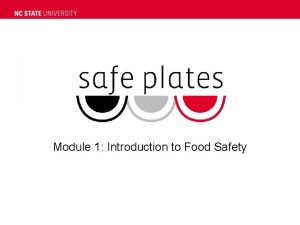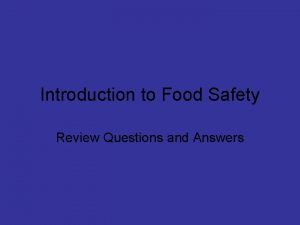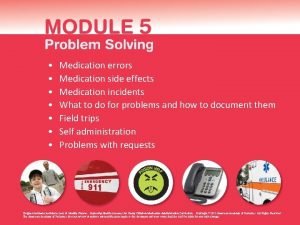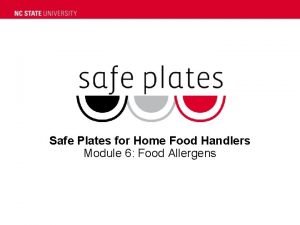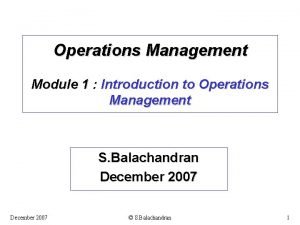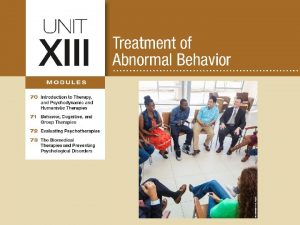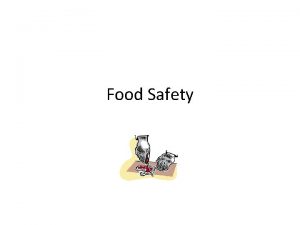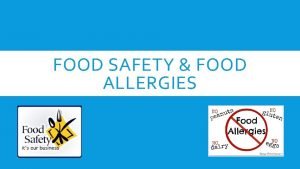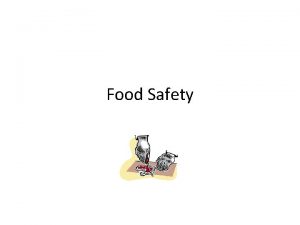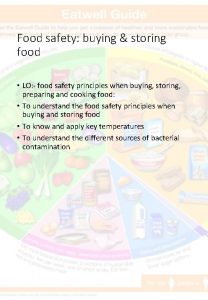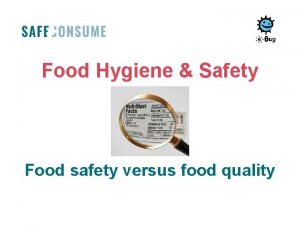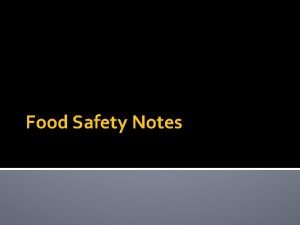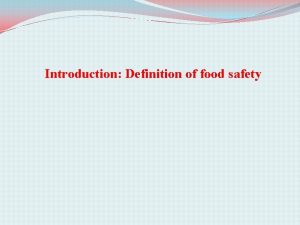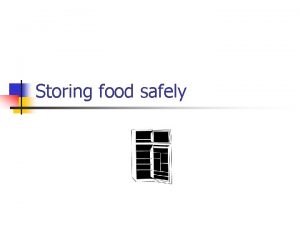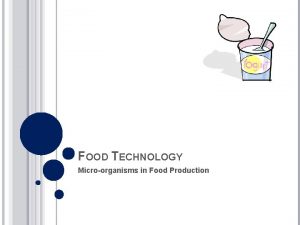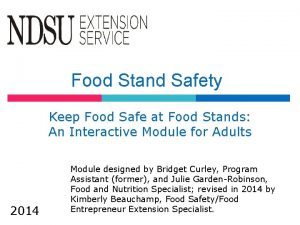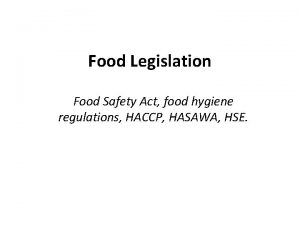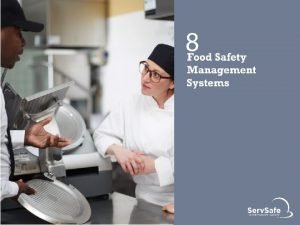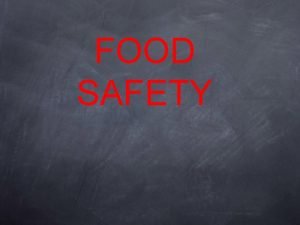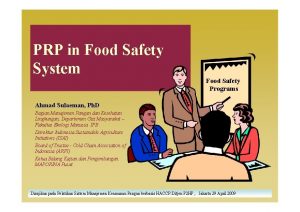Module 1 Introduction to Food Safety Why Is
























- Slides: 24

Module 1: Introduction to Food Safety

Why Is Food Safety Important?

What is Food Safety? What does food safety mean to you? What do you think is included in food safety? • Safeguarding or protection of food from anything that could harm consumers’ health. This includes all the practical measures involved in keeping food safe and wholesome through all the states of production to the point of sale or consumption.

Importance Of Food Safety • Foodborne illness sickens approximately 1 in 6 people in the United States every year – 48 million illnesses – 128, 000 hospitalizations – 3, 000 deaths – Estimated annual cost $51 – 77. 7 billion

Importance Of Food Safety • Many foodborne pathogen illnesses go unreported – Individuals recover and do not seek medical assistance – Estimated that there approximately 30 cases of unreported foodborne illness for each reported case

Think About The Case Study What are the potential negative impacts of foodborne illness? • Hospitalization • Fatality • Law suits • Legal action (business closed) • Increased insurance cost • Food discarded • Loss of customers • Loss of employment

Food Safety Culture • Food safety culture is a set of shared values that managers and their staff follow to produce and provide food in the safest manner. • Managers and staff: – Know the risks associated with the products or meals they produce – Know why managing the risks is important – Demonstrate they effectively manage those risks

Key Terms • Person in Charge (PIC) - The individual present at a food establishment who is responsible for the operation at the time of an inspection. A certified PIC should be present during all hours of operation. • Active Management Control - The responsibility of providing safe food for the consumer by developing and implementing food safety management systems to prevent, eliminate, or reduce the occurrence of foodborne illness risk factors. • Reasonable Care - Management’s responsibility to take all reasonable precautions and care to avoid committing a violation of FDA Model Food Code.

Federal Regulatory Control • Food and Drug Administration (FDA) is responsible for non-animal foods (some exceptions apply) – FDA Model Food Code is produced every four years. Code provides guidance for food establishment operation and inspections. States adopt versions of the code as they see fit. • United States Department of Agriculture (USDA) is responsible for regulating the safety of animal products and federally funded feeding programs. • Centers for Disease Control and Prevention (CDC) is responsible for the investigation of foodborne illness outbreaks in partnership with local health departments.

Local Regulatory Control • NC Dept. of Ag. And Consumer Services (NCDA&CS) regulates food products in partnership with the FDA, but not responsible for food service establishments. • NC Dept. of Health and Human Services (NCDHHS) is responsible for food service establishments. • Local Health Departments are responsible for the inspection of food service establishments, enforcing compliance to the FDA Food Code and investigation of food safety complaints and illnesses.

Potential Hazards in Food

Where Can Things Go Wrong? • Food safety can be compromised throughout the flow of food – Purchasing – Receiving – Storage – Preparation – Service • Safe Plates is laid out to follow the flow of food

Key Terms • Food Establishment - An operation that stores, prepares, packages, serves, vends food directly to the consumer, or otherwise provides food for human consumption such as a satellite or catered feeding location. • Food - Anything edible that people consume including water and ice.

Key Terms • Hazard - anything that could cause harm to consumers. There are three general categories: physical, chemical and biological. • Contamination - presence of any harmful or objectionable substance or object in food • Vehicles of contamination - hands, utensils, items that can carry microbes onto food and cause contamination

Key Terms • Foodborne illness/disease - illness caused by consumption of contaminated food • Case - an instance of a person becoming ill from food; suspected or confirmed • Foodborne disease outbreak - two or more cases of a similar illness that result from eating a common food

Types Of Hazards • Physical – Metal, glass, plastic – Rock, wood – Bone, shell, feather • Chemical – Allergens (Big 8) – Pesticides – Cleaners and sanitizers – Additives – Chemical leaching – Naturally occurring toxins • Plants, fish, shellfish, mushrooms

Types Of Hazards • Biological – Bacteria – Fungi (molds, yeasts) – Viruses – Parasites • Pathogens are microorganisms that cause disease • Most microorganisms are helpful, many are necessary for our health and production of foods

Sources Of Pathogens • Food handlers • Raw (not cooked or processed) foods • Contaminated water or ice • Soil • Pests and pets • Air, dust, dirt and food waste

Top Five Foodborne Pathogens CDC 2011 Estimate NUMBER OF CASES % OF TOTAL ILLNESSES Norovirus 5, 461, 700 58% Salmonella 1, 027, 500 11% Clostridium perfringens 965, 900 10% Campylobacter 845, 000 9% Staphylococcus aureus 241, 100 3% PATHOGEN

How Pathogens Make Us Sick • Foodborne Infection - illness caused by consuming pathogenic microorganisms that live and multiply in your body, making you sick. • Foodborne Intoxication - illness caused by consuming toxins (poisons) produced by pathogenic microorganisms in food. The pathogen does not need to be present to make you sick, only the toxin. • Toxin-mediated Infection - illness caused by consuming pathogenic microorganisms live that produce toxins in stomach or intestine, making you sick

Foodborne Infection Foodborne Intoxication Toxin-mediated Infection

Microorganism Growth and Control • The factors that influence microorganism growth and control: • Food, Acidity, Temperature, Time, Oxygen, Moisture

Factors Contributing to Foodborne Illness • Centers for Disease Control and Prevention (CDC) identified the most common factors for foodborne illness as being: – Food purchased from unsafe sources – Failure to cook food to correct temperature – Improper holding temperatures – Contaminated equipment – Poor personal hygiene

Highly Susceptible Populations • People who are more likely than the general population to experience foodborne diseases – Young (preschool age and younger) – Old (elderly) – Pregnant women and unborn babies – Immune compromised (weakened immune systems)
 Module 1 introduction to food safety
Module 1 introduction to food safety Cross contamination examples
Cross contamination examples Hey hey bye bye
Hey hey bye bye Food safety food security
Food safety food security Unit 2 food food food
Unit 2 food food food Food chain sequence
Food chain sequence Don't ask why why why
Don't ask why why why C device module module 1
C device module module 1 A supervisor's guide to safety leadership
A supervisor's guide to safety leadership Medication safety module
Medication safety module Module 1 basic safety
Module 1 basic safety Safe plates module 6
Safe plates module 6 Module 4 introduction to power tools
Module 4 introduction to power tools Module drawing
Module drawing Module 00105 exam introduction to construction drawings
Module 00105 exam introduction to construction drawings Operation management module
Operation management module Module 70 introduction to therapy
Module 70 introduction to therapy Nccer introduction to hand tools
Nccer introduction to hand tools Module 00102 introduction to construction math
Module 00102 introduction to construction math Module 00105-15 introduction to construction drawings
Module 00105-15 introduction to construction drawings Intro to mice
Intro to mice Module 3 introduction to hand tools test
Module 3 introduction to hand tools test Basic hand tools test answers
Basic hand tools test answers Introduction to entrepreneurship module pdf
Introduction to entrepreneurship module pdf Module 5 supply and demand introduction and demand
Module 5 supply and demand introduction and demand
